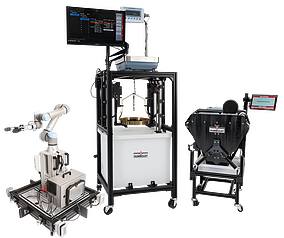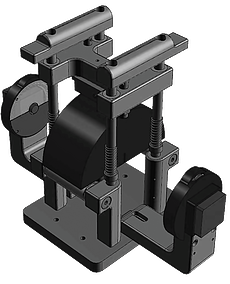
HM-7000.XX
Asphalt Mixture Automated Testing System
This Asphalt Mixture Automated Testing System with Zero Intervention is designed to automate Balanced Mix Design (BMD).

HA-1369
MiAS - Materials image Analysis System
MiAS is image analysis specifically designed to improve monotonic BMD tests.
New Technology for Balanced Mix Design
This Category showcases Humboldt’s new and innovative technology for use in Balanced Mix Design testing (BMD). As new BMD testing equipment becomes available you will find it here. Stay tuned for more new product announcements.
As the interest in Balanced Mix Design (BMD) evaluations for creating asphalt mixes for specific applications increases, so does the demand for QC/QA tests in daily practice. A well-designed mix with balanced resistance to cracking and rutting developed in the lab doesn’t necessarily ensure good field performance. Even the best lab designs can fail due to deviations during production and implementation. Currently, cracking and rutting tests are not included in production QC/QA procedures. This gap arises primarily from a shortage of qualified personnel and the challenges associated with rapidly cooling, conditioning, and testing hot cylindrical specimens directly from a Superpave gyratory compactor. Additionally, there are growing concerns about worker safety, particularly regarding injuries related to hot asphalt, large masonry saws, high-force testing machines, and the toxic chemicals commonly found in asphalt material testing labs.
Asphalt Mixture Automated Testing System
To this end, the Asphalt Mixture Automated Testing System with Zero Intervention has been developed by Dr. Fujie Zhou at Texas A&M University and manufactured by Humboldt. This cutting-edge system automates Balanced Mix Design (BMD) testing, enhancing the accuracy and efficiency of asphalt mixture testing while reducing the need for personnel involvement.
This innovative system meets the current demands of evaluative testing of BMD mixes, while addressing the need for QC/QA production testing to ensure a proper asphalt mix has been produced. In addition, this new testing system also addresses the industry’s challenges of a lack of trained/available lab techs, reliable and reproducible testing methods and safety concerns.
The Automated Testing System comprises an automated work concept built around a programmable, six-axis robotic arm, which controls the testing procedures while recording test results. The Testing System is sold by individual stations, which allows the lab to pick and choose the stations they require for their individual set up. When purchased in its entirety, the complete system provides a fully programmable and automatic testing system for Balanced Mix Design QC/QA setup.
The components of the Asphalt Mixture Automated Testing System, sold separately, are:
HM-7200 — Automated Asphalt Sample Feeding Carousel Machine
HM-7300 — Automated Asphalt Conditioning Chamber Machine
HM-7400 — Automated Asphalt Sample Loading Disposal Machine
HM-7500 — Automated Asphalt Staging-Storage Frame
HM-7600 — Automated Asphalt System Specimen Identification RFID
HM-7700 — Automated Asphalt System Saturated Surface Dry Machine
MiAS - Materials image Analysis System
Digital Image Correlation (DIC) has been used in research labs for some years, but cost, complexity, and computing power have prevented its use in routine daily testing. Today, cameras and AI are being used in ever-increasing areas of life to provide significant improvements. This is especially true in testing where they provide live recording of the testing process, which adds to detection of results and enhanced analysis.
MiAS, designed primarily for monotonic BMD testing, is a testing frame equipped with cameras, which record the test process and can be used in place of standard I-FIT, Ideal CT, and IDEAL RT frames. It can be used in any testing machine able to run monotonic BMD tests and will be directly available for integration with Humboldt’s HM-5125A Balanced Mix Design Load Frame.
The Unit’s cameras capture both sides of specimens during the test and use integrated microscope lighting to provide consistent illumination. The videos and images produced can be linked to the date, time and embedded metadata for each test specimen at the operator’s option. In use prior to a test, the camera’s software can be used to determine if specimens are correctly positioned in the frame. And, during the test the software can measure and record changes in height and horizontal diameter. It can also be used as a verification tool to assess test specimen performance under test conditions.
As MiAS is designed for 150mm diameter specimens, it can also be used to record testing of Hamburg and OT specimens. QR codes can be used for frame and specimen tracking.

